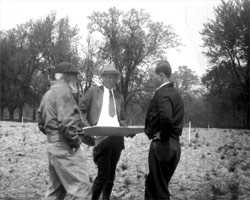
Mary K. Morgan and Maybeck, 1924
The Principia Commission
The Principia was founded in 1898 by Mary Kimball Morgan (1861-1948) as a school for Christian Scientists. By 1916 the school, located on Page and Belt Avenues in St. Louis, was academically accredited from kindergarten through junior college. Principia eventually outgrew its premises and began to consider plans for a four-year college in a new location. In 1923 San Francisco architect Bernard Ralph Maybeck (1862-1957) was retained and a master plan for the College was begun for a site west of St. Louis. In 1930 a new and larger campus site was chosen at Elsah, Illinois, and the next year, during the height of the Great Depression, construction was begun. In 1935, with most of the construction completed, the College moved from St. Louis to Elsah.
The design and construction of Principia College was the largest commission in Maybeck’s long career and became, in his own words, “his favorite child.” The Principia commission included general plans for two campus sites.
In addition, Maybeck produced designs for a chapel, six dormitories, a temporary dining room/kitchen complex, science building, field house, and two temporary classrooms. Among the unexecuted projects were designs for the “Great Hall,” Library and School of Nations complex, an administration building, faculty offices, and classroom cottages “styled” to express the disciplines that would be taught in them. One pastel rendering, for example, showed a French provincial cottage with hipped roof and half-timbering for French classes.
Maybeck’s Supervision and College’s Landmark Status
Although Maybeck supervised most of the three-and-one-half year construction project from his office in San Francisco, he remained deeply involved in the details of the work, reviewing daily photographs and weekly field reports from the construction site.

Conference in field: Maybeck, C.H. Sheppard, T.E. Blackwell, 30 April 1931
He made six visits to Elsah lasting an equivalent of eight months. During his Elsah visits he constructed two sample buildings, the “Mistake House” and the Spatz filling station in the Village of Elsah. He visited quarries, mills, and factories to find materials and production techniques needed to ensure the visual effects he desired. While in Elsah he also made significant adjustments to his own blueprints, leaving the plain trusses exposed in Anderson Hall, for example, placing random-width paneling in the Chapel; and insisting, sometimes over the objections of the college administrators, on the use of such touches as rubblestone trim around the doors and windows of Rackham Court. By the time it was completed, the Principia commission represented a significant part of Maybeck’s oeuvre.
On April 19, 1993, thanks largely to the efforts of Principia history professor Charles B. Hosmer, Jr. (1932-1993), Principia College was granted National Historic Landmark status by the United States Department of the Interior. The text that follows for the historic district and description of Maybeck buildings is excerpted from the Landmark application written by Charles Hosmer. Accompanying the text are extensive color photographs of architectural details taken by Jeanne Colette Collester. Hopefully they will assist the researcher and website user in visualizing the extraordinary richness of this commission. I also wish to acknowledge generous institutional support from President George Moffett and Dean G. Curtis Martin; valuable encouragement and technical supervision from Marty DeWindt and Jonathan Hosmer; inestimable archival assistance from Jane H. Pfeifer, and talented expertise from site designer Samuel Ramaji.

Maybeck viewing Buck House, 24 April 1934
The College’s designation as a National Historic Landmark is a fitting tribute to the inspiration of both the College’s administrators and its architect. Maybeck once remarked: “If the architectural composition which is to be Principia College lives up to the ideals of the institution and properly expresses them, the physical form of the college will have the power to move the hearts of men and to lift their spirit-and the world will care.”
Jeanne Colette Collester
Site Developer
If you’d like to ask questions about Principia College’s current collections, e-mail archivist@principia.edu.
| Introduction | Historic District | About the Collection |









